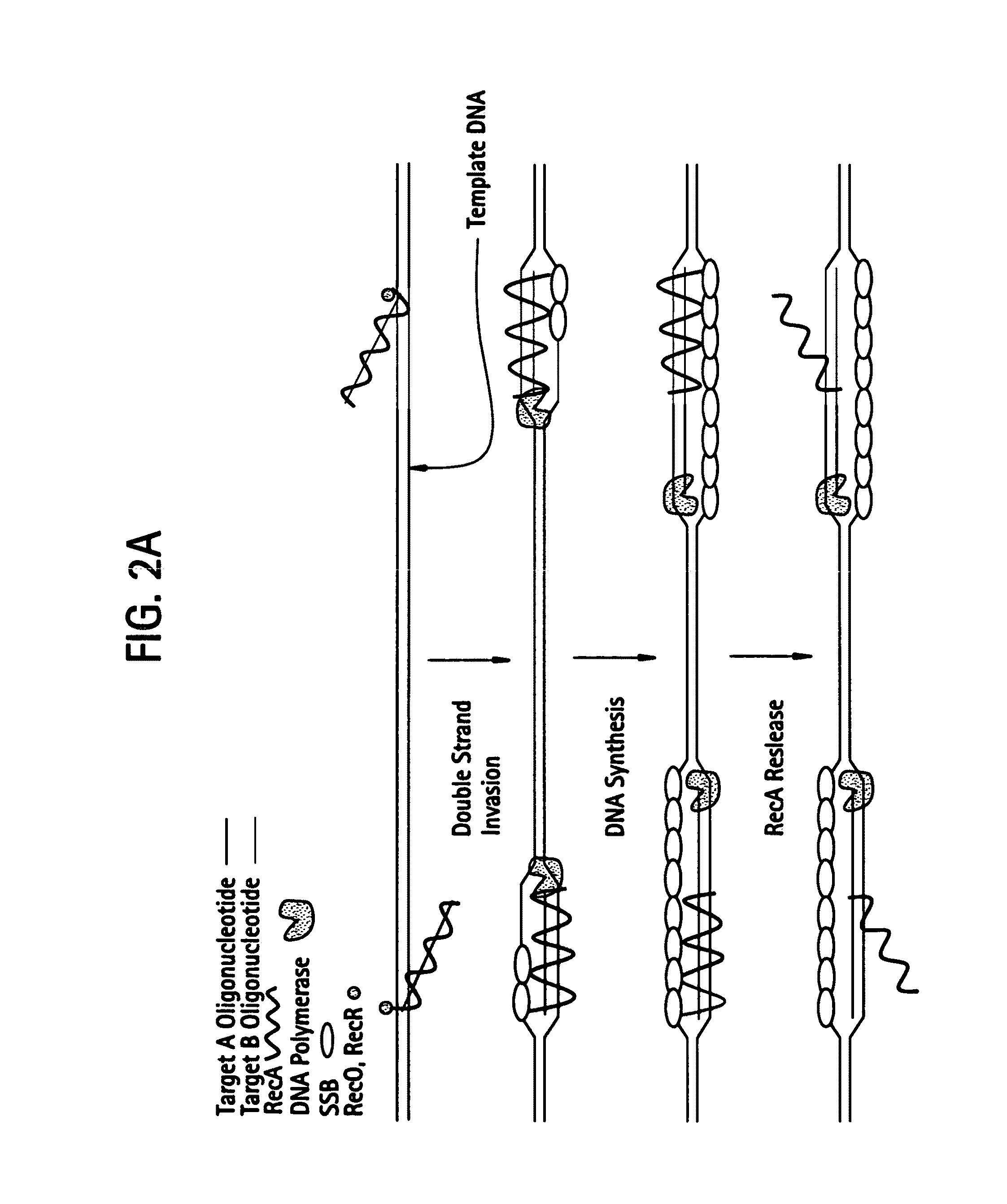Recombinase polymerase amplification
a technology of recombinase and polymerase, applied in the direction of transferases, instruments, enzymology, etc., can solve the problems of inability to automate the approach of adding fresh polymerase, limited in a number of ways, and inability to achieve high activity, improve the design of oligonucleotides
- Summary
- Abstract
- Description
- Claims
- Application Information
AI Technical Summary
Benefits of technology
Problems solved by technology
Method used
Image
Examples
example 1
An Example of a Leading Strand Recombinase-polymerase Amplification (lsRPA)
[0528]DNA sequences can be amplified using leading strand synthesis according to the Recombinase-Polymerase amplification (RPA) method depicted in FIG. 1. FIG. 1 shows RecA / primer loading. Prior to the addition of template DNA and / or Polymerase, RecA and SSB will compete for binding to single-stranded oligonucleotide primers. In the presence of a RecR and RecO, RecA is selectively stabilized onto the single-stranded primers forming RecA nucleoprotein filaments in a complex with RecO and RecR. This complex is competent to invade double-stranded DNA to form a D-loop at sites homologous to the oligonucleotide primers. Alternatively, RecA, RecO and RecR can be pre-loaded onto oligonucleotide primers prior to the introduction of SSB to the reaction mixture.
[0529]The following details the likely composition of an RPA reaction assembled with E. coli recA and E. coli recO and recR stabilizing agents:
D-Loop Formation / ...
example 2
Nested RPA
[0537]The RPA reaction is performed as described in Example 1. A fraction of one tenth ( 1 / 10) and one hundredth ( 1 / 100) of the reaction is removed and used in place of the DNA template in a second round of RPA. LsRPA, leading / lagging RPA, and combinations thereof may be used for nested RPA.
example 3
Simultaneous Leading and Lagging Strand Recombinase-polymerase Amplification
[0538]DNA sequences can be amplified using simultaneous leading and lagging strand synthesis according to the Recombinase-Polymerase amplification (RPA) method depicted in FIG. 2. This figure specifically illustrates lsRPA. FIG. 2A shows that RecA / primer nucleoprotein filaments invade double stranded template DNA preferentially associating with homologous target sites. As D-loops are formed and synthesis proceeds, displaced single stranded DNA becomes coated with SSB (FIG. 2A). RecA release from double-stranded DNA can occur via ATP hydrolysis in a 5′-3′ direction or as a result of helicase / resolvase or polymerase activity (FIG. 2A). As synthesis continues (FIG. 2B), polymerases encounter SSB bound, displaced single-stranded template. Double-stranded target sites are re-invaded by RecA / primer nucleoprotein filaments. Subsequent rounds of lsRPA proceed from re-invaded sites (FIG. 2B).
[0539]The following detai...
PUM
| Property | Measurement | Unit |
|---|---|---|
| temperatures | aaaaa | aaaaa |
| reaction volume | aaaaa | aaaaa |
| reaction volume | aaaaa | aaaaa |
Abstract
Description
Claims
Application Information
 Login to View More
Login to View More - R&D
- Intellectual Property
- Life Sciences
- Materials
- Tech Scout
- Unparalleled Data Quality
- Higher Quality Content
- 60% Fewer Hallucinations
Browse by: Latest US Patents, China's latest patents, Technical Efficacy Thesaurus, Application Domain, Technology Topic, Popular Technical Reports.
© 2025 PatSnap. All rights reserved.Legal|Privacy policy|Modern Slavery Act Transparency Statement|Sitemap|About US| Contact US: help@patsnap.com



